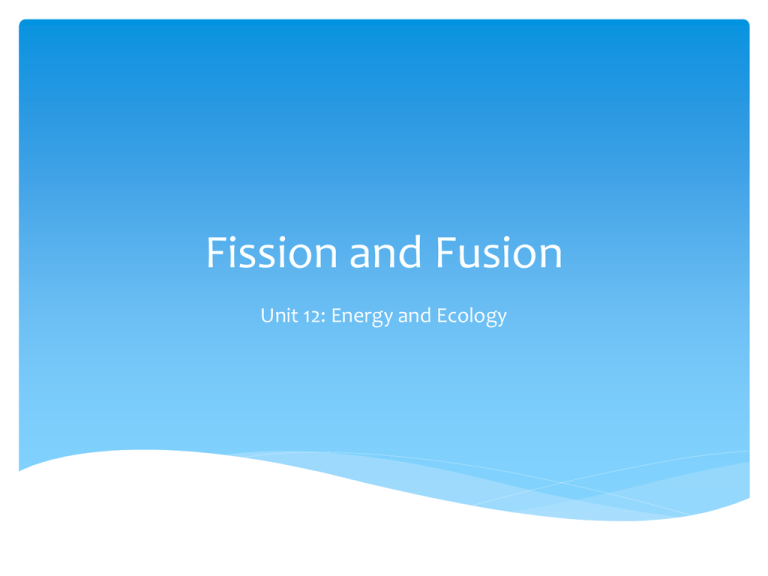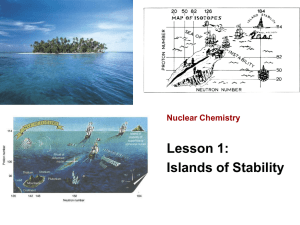Fission and Fusion
advertisement

Fission and Fusion Unit 12: Energy and Ecology What is this? Nuclear Reactions In chemical reactions electrons are transferred or shared between atoms. Nuclear reactions involve changes in ATOMIC NUCLEI. For ONE MINUTE, describe what you think is happening in the illustration above in your notes. Nuclear Fission FISSION is a nuclear reaction that occurs when a large nucleus is bombarded with a small particle, a neutron, and it splits into smaller/lighter nuclei. Nuclear power plants are powered by nuclear fission reactions to generate electricity. Uranium-235 is the typical fuel for nuclear fission reactions. A CHAIN REACTION is a self-sustaining reaction (without outside influence) in which neutrons released in fission produce an additional fission – process repeats. Nuclear Reactions For ONE MINUTE, describe what you think is happening in the illustration below. What are the reactants in the nuclear reaction above? What is the main product of this nuclear reaction? Is Helium radioactive? Nuclear Fusion FUSION is the process that powers the Sun (stars). In this reaction two hydrogen atoms combine (fuse) to form a larger/heavier atom of helium. A Nuclear Fusion Reaction needs extreme heat and pressure like that of the Sun to occur. Elements What differences do you notice by looking at these three atoms? What are the similarities do you notice? Are these atoms of the same element? How do you know? What is the name of this element? Hydrogen How do you know? Each one has the same number of protons. How many protons, electrons, and neutrons does each version of a hydrogen atom have? H-1 P = 1, N = 0, E = 1 H-2 P = 1, N =1, E = 1 H-3 P = 1, N = 2, E = 1 Isotopes of Hydrogen These three atoms are known as the Isotopes of Hydrogen. The correct way to distinguish between different isotopes of the same atom is to write them in Isotope Notation as shown below. Isotopes An Isotope is an atom of the same element with the same number of protons, but a different number of neutrons. How many isotopes does an atom of hydrogen have? 3 In the picture, what do numbers “1” “2” and “3” represent? The MASS NUMBER of each isotope. Mass # = # of Protons + # of Neutrons in the nucleus of the atom. Isotopes What is the atomic number of all three isotopes of carbon? Are their atomic masses the same? How do you know? Which isotopes of carbon are stable atoms? Which isotope is said to be “radioactive”? What makes it radioactive? Isotopes What causes a nucleus become unstable? If the ratio of Neutrons to Protons exceeds certain limits; a.k.a TOO Many Neutrons in the Nucleus Ex: Large atomic nuclei, with more than 83 protons are unstable. Uranium and plutonium are examples. Another example, H-3 (tritium), is also radioactive too even though it is a small atom. Isotopes of atoms with unstable nuclei are called radioisotopes. Isotopes What is radiation? Penetrating waves from Alpha, Beta or Gamma Rays. What are the sources of radiation? Who discovered radioactivity? Pierre and Marie Curie What is radioactivity? The process of giving off penetrating rays. (γ, α, β)






